Nafpaktos - we are on the way to Peloponnesus
- Written by Portal Editor
Nafpaktos - After an extensive tour of ancient Delphi in the afternoon and one stormy night at the campsite, which has led to unique clear view of the ancient ruins and the surrounding areas, we had first visited the Oracle of Delphi and the Museum in the morning, which is located below the ancient Delphi.
Crowded by the busloads of tourists that were funneled into international groups through the museum, however, we interrupted the visit to the museum prematurely, so much disturbing was the confusion of tongues.
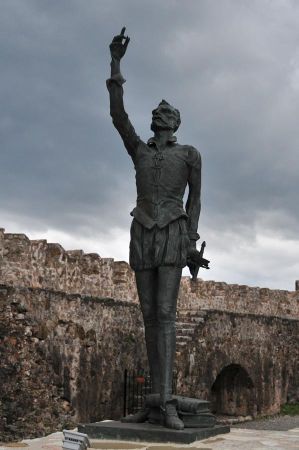 Better repeat in late autumn or at the beginning of spring again.
Better repeat in late autumn or at the beginning of spring again.
So we continued on the way to the Peloponnesus, as once again we noticed of being little hungry, which prompted us to leave the expressway of Delphi toward Patras shortly before crossing to Peloponnesus.
Nafpaktos or Naupaktus was the place in which we got in and it should turn out to be fantastic stopover a little later.
Nafpaktos is the western Greek port city at the entrance to the Gulf of Corinth, which in its history was very important, from the monumental castle and port facilities there is a first impressive report of locals and thus compelled us to stay little longer.
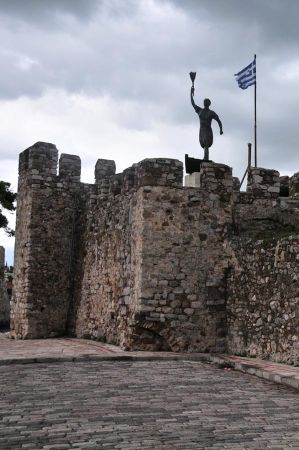 Naupaktos was one of the main harbours of western Locris in ancient times.
Naupaktos was one of the main harbours of western Locris in ancient times.
In 455 BC Nafpaktos was wrested from the Locrians by the Athenians and staffed with volatile Messenians.
In the Peloponnesian War it was a naval station of Athens, but they were snatched 405 BC and the Messenians were expelled.
338 BC the Aetolians seized the city, which they long defended against the Romans, but without success, in 191 BC it got lost.
In 217 BC the Peace of Naupactus at the end of the Social War (220-217) between Philip V of Macedonia and its allies against the Aetolians and their allies was ended here.
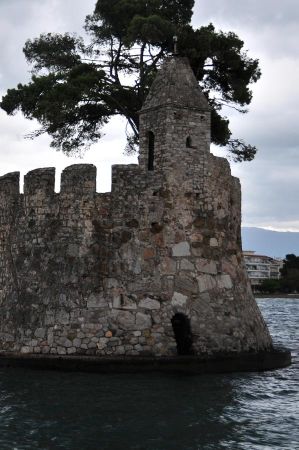 In the Middle Ages the city was left to the Venetians, which was so heavily fortified that in 1477 a 30,000-strong Ottoman army after four months of siege had to withdraw again unsuccessful.
In the Middle Ages the city was left to the Venetians, which was so heavily fortified that in 1477 a 30,000-strong Ottoman army after four months of siege had to withdraw again unsuccessful.
In 1499, it was the Ottoman Bayezid II. forces with an army of 150,000 men to conquer the town.
At the Battle of Lepanto on October 7, 1571, Venetian-Spanish fleet lead by Don Juan de Austria, defeated the Ottoman fleet stationed there.
It was the last major and extremely bloody galley battle in the Mediterranean, which heralded the end of the Turkish occupation.
A monument at the Venetian harbor recalls Miguel de Cervantes, who lost his left hand in this battle.
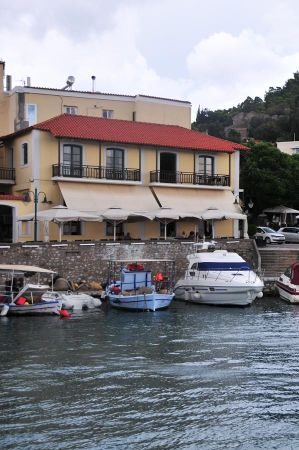 Since 1678 Nafpaktos was, named as Lepanto again, in Venetian possession, but was again awarded into the Ottoman Empire by the Treaty of Karlowitz in 1699.
Since 1678 Nafpaktos was, named as Lepanto again, in Venetian possession, but was again awarded into the Ottoman Empire by the Treaty of Karlowitz in 1699.
As a result of the Greek War of Independence, Nafpaktos was handed to the Greeks on 27th of March 1829th
After a delicious meal on the open space right to the harbor, we saw evidence during a short tour of the historical significance of the place.
There is no question here it is worth for a longer stopover.
For sure, depending on the weather conditions as well.
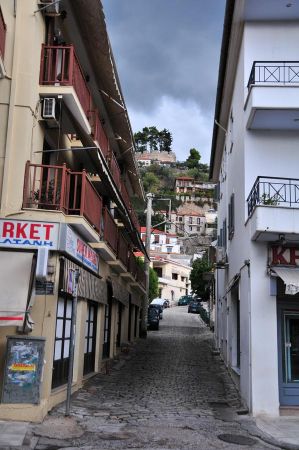 As again then violent thunderstorms teased up, we went back up on our way, today's destination is Gythion.
As again then violent thunderstorms teased up, we went back up on our way, today's destination is Gythion.
We had initially thought of the passage by ferry (not just for financial reasons, because ferry crossing only costs 6.40 Euro).
We now changed our opinion and would rather use the bridge to cross the Gulf of Corinth.
Please read as well:
The impossing Rotunda of Thessalonica
Galerius Arch - late Roman triumphal arch in Thessalonica
-
 Nafpaktos Harbour & Castle
Nafpaktos Harbour & Castle
Nafpaktos Harbour & Castle
Nafpaktos Harbour & Castle
-
 Nafpaktos Harbour & Castle
Nafpaktos Harbour & Castle
Nafpaktos Harbour & Castle
Nafpaktos Harbour & Castle
-
 Nafpaktos Harbour & Castle
Nafpaktos Harbour & Castle
Nafpaktos Harbour & Castle
Nafpaktos Harbour & Castle
-
 Nafpaktos Harbour & Castle
Nafpaktos Harbour & Castle
Nafpaktos Harbour & Castle
Nafpaktos Harbour & Castle
-
 Nafpaktos Harbour & Castle
Nafpaktos Harbour & Castle
Nafpaktos Harbour & Castle
Nafpaktos Harbour & Castle
-
 Nafpaktos Harbour & Castle
Nafpaktos Harbour & Castle
Nafpaktos Harbour & Castle
Nafpaktos Harbour & Castle
-
 Nafpaktos Harbour & Castle
Nafpaktos Harbour & Castle
Nafpaktos Harbour & Castle
Nafpaktos Harbour & Castle
-
 Nafpaktos Harbour & Castle
Nafpaktos Harbour & Castle
Nafpaktos Harbour & Castle
Nafpaktos Harbour & Castle
-
 Nafpaktos Harbour & Castle
Nafpaktos Harbour & Castle
Nafpaktos Harbour & Castle
Nafpaktos Harbour & Castle
-
 Nafpaktos Harbour & Castle
Nafpaktos Harbour & Castle
Nafpaktos Harbour & Castle
Nafpaktos Harbour & Castle
-
 Nafpaktos Harbour & Castle
Nafpaktos Harbour & Castle
Nafpaktos Harbour & Castle
Nafpaktos Harbour & Castle
-
 Nafpaktos Harbour & Castle
Nafpaktos Harbour & Castle
Nafpaktos Harbour & Castle
Nafpaktos Harbour & Castle
-
 Nafpaktos Harbour & Castle
Nafpaktos Harbour & Castle
Nafpaktos Harbour & Castle
Nafpaktos Harbour & Castle
-
 Nafpaktos Harbour & Castle
Nafpaktos Harbour & Castle
Nafpaktos Harbour & Castle
Nafpaktos Harbour & Castle
-
 Nafpaktos Harbour & Castle
Nafpaktos Harbour & Castle
Nafpaktos Harbour & Castle
Nafpaktos Harbour & Castle
-
 Nafpaktos Harbour & Castle
Nafpaktos Harbour & Castle
Nafpaktos Harbour & Castle
Nafpaktos Harbour & Castle
-
 Nafpaktos Harbour & Castle
Nafpaktos Harbour & Castle
Nafpaktos Harbour & Castle
Nafpaktos Harbour & Castle
-
 Nafpaktos Harbour & Castle
Nafpaktos Harbour & Castle
Nafpaktos Harbour & Castle
Nafpaktos Harbour & Castle
https://www.alaturka.info/en/greece/peloponnese/3448-traditional-nafpaktos-on-the-way-to-peloponnesus#sigProId51ec13b652
